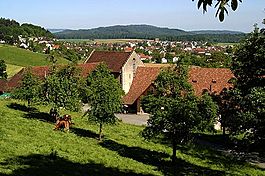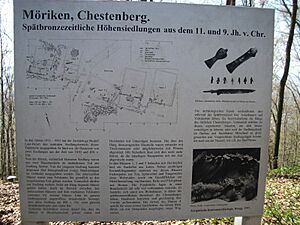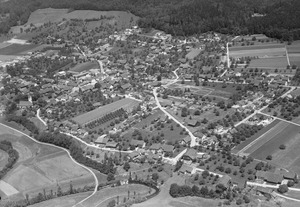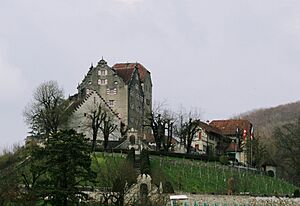Möriken-Wildegg facts for kids
Quick facts for kids
Möriken-Wildegg
|
||
|---|---|---|
 |
||
|
||
| Country | Switzerland | |
| Canton | Aargau | |
| District | Lenzburg | |
| Area | ||
| • Total | 6.61 km2 (2.55 sq mi) | |
| Elevation | 387 m (1,270 ft) | |
| Population
(Dec 2020 )
|
||
| • Total | 4,561 | |
| • Density | 690.0/km2 (1,787.1/sq mi) | |
| Postal code |
5103
|
|
| Surrounded by | Auenstein, Birr, Brunegg, Holderbank, Lenzburg, Lupfig, Niederlenz, Othmarsingen, Rupperswil, Veltheim | |
Möriken-Wildegg is a town in Switzerland. It is located in the Lenzburg district. This district is part of the canton of Aargau.
Contents
- Exploring Möriken-Wildegg's Past
- Understanding Möriken-Wildegg's Geography
- Möriken-Wildegg's Coat of Arms
- Who Lives in Möriken-Wildegg?
- Important Heritage Sites
- Möriken-Wildegg's Economy
- Religious Life in Möriken-Wildegg
- Transportation in Möriken-Wildegg
- Education in Möriken-Wildegg
- Famous Person from Möriken-Wildegg
- See also
Exploring Möriken-Wildegg's Past
The area where Möriken-Wildegg now stands was first settled a very long time ago. People lived here during the Late Bronze Age. This was around 1050 to 1000 BC and again around 850 BC.
Early Settlements and Roman Times
On a hilltop called Kestenberg, people built homes from logs. They also worked with bronze there. Later, during the Roman era, a farm existed near the Lehmgrube river. Möriken-Wildegg was first written about in 1283. It was called de Moerinchon back then.
Religious History and Churches
For many years, the people of Möriken-Wildegg went to church in Staufberg. This changed in 1565 when they joined the Holderbank church. A chapel for Saint Antonius was mentioned in the 1200s. It was replaced by a new building in 1949. A new Catholic church was built in 1967.
Growing the Economy and Industries
In the past, the town's economy relied on farming and making wine. In the 1600s, a rich family started raising animals. In the 1700s, people began processing cotton at home. A cotton printing company opened in 1775 but closed in 1850.
A large cement factory was built in 1890. It employed up to 850 people by 1912. A factory making copper wire opened in 1920. It had about 200 workers in 1992.
The Arrival of Railways
Möriken-Wildegg grew a lot after a train station opened in 1858. This station was on the line between Aarau and Brugg. In 1895, another train line, the Seetalbahn, connected to the town. This second connection was replaced by a bus service in 1984.
Community Life and Events
Starting in 1890, popular operetta shows were held in Möriken-Wildegg. An operetta is like a light opera with singing and talking. In 1959, a town hall was built with 600 seats for events.
Understanding Möriken-Wildegg's Geography
Möriken-Wildegg covers an area of about 6.6 square kilometers (2.5 square miles). A large part of this land is used for farming, about 37.6%. Forests cover another big portion, about 35.2%.
Land Use and Natural Features
About 25.2% of the land has buildings or roads. Rivers and lakes make up 1.8% of the area. A very small part, 0.3%, is land that cannot be used.
Most of the forested land is dense forest. Some areas have orchards or small groups of trees. For farming, 28% of the land grows crops. Another 7.9% is used for pastures where animals graze. Some land is also used for orchards or vineyards.
Town Layout and Landmarks
The town is in the Lenzburg district. It includes the main village of Möriken. It also has Wildegg Castle and the village part of Wildegg. The settlement of Hard is also part of the town. A bridge over the Aare river was built in 1870, replacing an old ferry.
Möriken-Wildegg's Coat of Arms
The town's coat of arms shows a Moor's Head. It is described as Or Moor's Head guardant proper. This means it's a black head on a gold background, looking forward.
Who Lives in Möriken-Wildegg?
Möriken-Wildegg has a population of about 4,500 people. As of June 2009, about 19.2% of the people living here were from other countries. The population grew by about 8.9% between 1997 and 2007.
Languages Spoken and Age Groups
Most people in Möriken-Wildegg speak German, about 90.6%. Italian is the second most common language, spoken by 2.8% of the people. Serbo-Croatian is third, spoken by 1.7%.
In 2008, about 9.7% of the population were children aged 0-9. Teenagers aged 10-19 made up 12.2%. Adults aged 20-59 made up a large part of the population. Older adults, aged 60 and above, made up about 21.2%.
Homes and Households
In 2000, the average home had 0.54 residents per room. About 59.6% of homes were owned by the people living in them. This means they did not pay rent.
There were 1,384 private homes and apartments in 2000. The average household had 2.4 people. In 2008, 44.9% of all homes were single-family houses. Only 1.3% of apartments were empty.
Political Choices
In the 2007 national election, the most popular political party was the SVP. They received 40.8% of the votes. Other popular parties were the SP (18.2%) and the FDP (15.7%).
Population Over Time
The table below shows how the population of Möriken-Wildegg has changed over many years:
| Historical population | ||
|---|---|---|
| Year | Pop. | ±% |
| 1764 | 426 | — |
| 1850 | 821 | +92.7% |
| 1900 | 1,161 | +41.4% |
| 1950 | 2,134 | +83.8% |
| 2000 | 3,413 | +59.9% |
Important Heritage Sites
Wildegg Castle is a very important historical site. The Kestenberg Bronze Age settlement is also a special heritage site. Other important places include the Gasthof Bären building and Wildegg's Catholic Church of St. Antonius. Some houses on Effingerweg are also listed. The entire village of Wildegg is recognized as a Swiss heritage site.
Möriken-Wildegg's Economy
In 2007, the unemployment rate in Möriken-Wildegg was low, at 1.72%. In 2005, 42 people worked in the primary sector. This means they worked in farming or forestry.
Jobs and Businesses
About 332 people worked in the secondary sector. This includes manufacturing and construction. There were 38 businesses in this sector. The largest number of people, 750, worked in the tertiary sector. This sector includes services like shops, offices, and healthcare. There were 121 businesses in this sector.
Commuting for Work
In 2000, 1,709 people lived in Möriken-Wildegg and had jobs. About 73.8% of these people worked outside the town. However, 675 people came into Möriken-Wildegg for work.
There were 1,122 jobs available in the town. For getting to work, 14.4% of workers used public transportation. A larger number, 51.1%, used a private car.
Religious Life in Möriken-Wildegg
Based on the 2000 census, 25.1% of the people were Roman Catholic. A larger group, 56.9%, belonged to the Swiss Reformed Church. A small number of people, about 0.15%, were part of the Christian Catholic faith.
Transportation in Möriken-Wildegg
Möriken-Wildegg is located on the Baden–Aarau railway line. The town has its own train station, called Wildegg railway station. This makes it easy for people to travel by train.
Education in Möriken-Wildegg
Many adults in Möriken-Wildegg have a good education. About 76% of people aged 25 to 64 have finished high school or gone on to college.
Student Enrollment
In the 2008/2009 school year, there were 284 students in primary school. There were 132 students attending secondary school. Also, 181 students were studying at a university or college level in the town.
Famous Person from Möriken-Wildegg
The well-known American actor Yul Brynner was a Swiss citizen of Möriken-Wildegg. He was born on July 11, 1920, and passed away on October 10, 1985. His Swiss background came from his father, Boris Julievich Bryner, and his grandfather, Jules Bryner. Jules Bryner was born near Geneva and had a Swiss German background. He died just three months before Yul Brynner was born.
See also
 In Spanish: Möriken-Wildegg para niños
In Spanish: Möriken-Wildegg para niños










